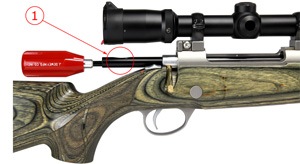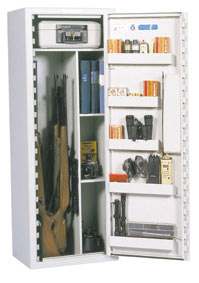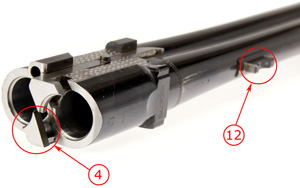GUN CLEANING GUIDE

Step-by-step (Repeating Rifle)
Before cleaning any firearm, and anytime you pick one up, make sure it’s unloaded.
1. Start by removing the bolt from the rifle and inserting a Bore Guide, a Bore Guide is a rifle cleaning protection tool you insert insted of the bolt during cleaning. The bore guide guides the cleaning rod through the action and chamber in to the bore. The Bore Guide also protect the chamber from damage and it guides the rod through the action and in to the barrel. It also prevents dirt and solvent from getting into the mechanism.
 2. Attach a patch on the jag and soak it with carbon solvent. Then pass it from the chamber (bore guide) forward to the muzzle. When the patch comes out of the muzzle you remove the patch and then pull back the rod without a patch. Repeat the procedure about 2-4 times. All rod handling should be done from the rear (from the chamber and out through the muzzle).
2. Attach a patch on the jag and soak it with carbon solvent. Then pass it from the chamber (bore guide) forward to the muzzle. When the patch comes out of the muzzle you remove the patch and then pull back the rod without a patch. Repeat the procedure about 2-4 times. All rod handling should be done from the rear (from the chamber and out through the muzzle).
Patch & Jag: When you run the first patch through the bore it can be heavy resistance because of all the residue deposits in the barrel, a trick is then not to center the patch on the jag but rather out towards the edge. Then the patch passes easier through the barrel. As the bore becomes cleaner, then pin the patch towards the center.
3. Screw on a bronze brush on the cleaning rod, soak it with carbon solvent and pass it through the barrel. Pull the bronze brush back and forth through the bore. Make sure the entire brush comes out of the barrel before turning and pulling the other way (this is important to prevent damage to the barrel and the barrel's muzzle). Pull 10-15 moves back and forth in the barrel with the bronze brush.
4. Wet a patch with carbon solvents and pass through the barrel. The first patch will be very dirty. Pull a few more patches through the barrel. If the patches still is black or gray repeat steps 3 and 4 again. When the patches only have a blue or green hue or are mostly white, move on to the steps 5.
5. Dry the barrel with a dry patch 1-3 times.
6. Remove the bore guide and clean it before putting it back into the rifle.
7. Then it's time for the Copper Solvent. The Copper Solvent removes the copper deposited in the barrel after firing bullets with copper metal jacked. Wet a patch with copper solvents and pass it through the barrel. When the patch comes out of the muzzle remove the patch and then pull back the rod. Wait about 2 minutes before pulling through the next patch with copper solvent. (The patches now coming out the barrel with a blue-green colored stain if you have copper residue in the bore)
8. Put a nylon brush on the cleaning rod, soak the brush with copper solvent and run it it back and forth in the barrel 5- 10 times. Then allow the copper solvent to work for about 5 minutes in the barrel.
9. Then take a patch and soak it with copper solvent, pass it through the barrel. Repeat 2-3 times. If the patches coming out completely white or very little blue / green then go to step 10, otherwise repeat steps 7-9.
10. Dry the barrel with a dry patch 1-3 times.
11. Remove the bore guide and clean it before putting it back into the rifle.
12. After cleaning it is recommended to oil rust protect the bore with gun oil. Soak a patch with gun oil and pass through the barrel. Repeat 1-2 times. Oil the bolt and other gun metal parts. (If you are going to use the gun immediately, you do not need to oil the bore. The bore should be free of excess oil when fired)
13. Finished
Before using the gun, the bore must be dried from excess oil. If you fire the gun with to much oil in the barrel it could damage the gun!
Some good advice for Gun Care.
1. On a new rifle and new rifle barrels make a Break-In. Read more about Break-in here.
2. Use a Bore Guide, read more about Bore Guide here.
3. Use something to attach the rifle to during the gun maintenance, such as a shooting rest or with clamps.
4. To prevent getting solvent on the gun stock during cleaning (which may leave marks), wrap a plastic bag over the gun stock.
5. If you do gun care indoors, a bottle that you put over the muzzle or a Patch Catcher can prevent splashing and reduce solvent odor. Also, be sure to be in a well-ventilated area when using solvents, preferably outdoors.
6. Wear protective gloves, it is chemicals you handle.
7. If you do the gun cleaning on the shooting range immediately after the shooting when the barrel is still warm, it is easier to clean the barrel.
8. Use a pipette to apply solvent.
How to store the gun.

The gun should be stored dry in 20-60 percent relative humidity. A too dry and hot place can be harmful to a wooden stocks as it can dry out and crack the wood.
When the relative humidity exceeds 70 percent, metal begins to rust without being wet. To protect the metal against rust it is recommended that all metal parts are protected with a thin coat of gun oil.
A good way to keep track of humidity (which varies throughout the year) is to get a hygrometer. A hygrometer is an instrument that measures humidity.
Shotgun Cleaning Guide
Gun care for shotguns should be done no later than 200-300 shots are fired. But it does not hurt to do gun care more often as the shotgun stays in better condition. If you have been out in humid weather, you should always do gun care to prevent rust. Below you will find a guide on gun care on shotguns. Since there are many different designs on shotguns, the gun care may differ a bit, but we have tried to make the guide fairly general so that it will fit most of the shotguns.
The Shotgun must be dry before you start the gun care.
Step-by-step (Shotgun)
Before cleaning any firearm, and anytime you pick one up, make sure it’s unloaded.
1. Pull a patch through the barrel to loose debris and residue.
2. Unscrew any chokes and clean them.
3. Soak a patch with carbon solvents or lead solvents and push through the barrel. Then let the solvent work for a few minutes. Then push some clean patches through the barrel. If the patches are still dirty, repeat the step again. If burnt debris remains scrub with shotgun bronze brush. Soak the brush with solvent for better effect. Then wipe the bore dry.
4. Then clean ejectors and oil very sparingly.
5. Clean the locking bolt. Apply grease to the barrel hook and bites.

6. Clean the inside of the reciver with a cleaning brush.
7. Clean the exterior pipes, dissolve dirt with gun oil. Wipe clean the barrels and apply a thin coat of gun oil as rust protection.
8. Oil the barrels inwards with a cotton swab.
9. Oil the shockes and apply some grease to the threads.
10. Apply some grease on the bolt or pins in the reciver.
11. Apply grease on the hinge pin where the forearm attach to the reciver.
12. Apply grease on forearm locking.
13. If necessary oil the wood stock with Gun Stock Oil.
Important: Do not drop oil into the base of the breech block as there is a risk that it will bind dust and dissolve the wood.![]()
Storage of the Shotgun
The shotgun should be stored dry in 20-60 percent relative humidity. A too dry and hot place can be harmful to a wooden stock as it can dry out and crack. The shotgun can be stored standing on the barrels as it prevents any excess gun oil from flowing into the breech block.
